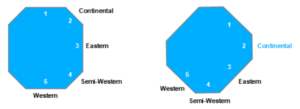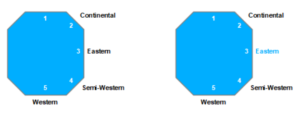Learn backhand
In 5 steps to the perfect tennis backhand as a beginner
In 5 steps to the perfect tennis backhand as a beginner
The backhand in tennis is initially identified by many tennis beginners as a weak point, because the process is less natural than with the forehand. Especially in the beginning, it is important to gain the necessary stability on the backhand side in order to at least not make any unforced errors.
The backhand can be played either one-handed or two-handed. Often tennis beginners are taught the two-handed backhand, because it is easier to learn. With a strong backhand, you can add more variety to your game and save valuable energy because you don’t have to go around the backhand to play a forehand again.
Below we explain to tennis beginners the 5 steps to the perfect tennis backhand: from the backhand grip, to the backswing, the movement and the outswing, to backhand tips.
1. Tennis backhand grip
To play the backhand successfully, the right backhand grip in the respective situation is the basis for a good stroke. Similar to the forehand, we basically distinguish between two backhand variations:
a) Backhand topspin
In tennis, the backhand topspin is usually played either very stably or aggressively in order to stay in the rally or to put one’s own stamp on the rally.
In addition, it is possible to play the backhand topspin somewhat more passively, e.g. as a lob to outplay the opponent. All backhand topspin strokes are characterized by the forward spin and a faster bounce away.
For playing backhand topspin – one-handed or two-handed – we recommend the so-called Continental grip. The racket is slightly bent forward at the top in the lateral position.
slightly bent forward at the top.
As with the forehand, your strong hand again grips the grip as far down as possible. For the two-handed backhand, you also use your weaker hand – the left hand if you are right-handed. Both hands are close together and touch to give the backhand even more stability.

b) Backhand slice
The backhand slice is played in tennis either in defense as an emergency stroke or as a tactical variation to get back into the rally or to disturb the opponent’s rhythm of play by having less speed.
However, the backhand slice can also be played as an attacking ball, as the tennis ball does not bounce high due to the backspin, forcing the opponent low.
To play the backhand slice, we recommend the so-called Eastern grip.

The two-handed backhand topspin is the best introduction for tennis beginners on the backhand side, so we focus the following on the backhand topspin in the Continental grip.
2. Tennis backhand backswing
You are in the center of the court and wait for your opponent to hit you. As always, you hold the tennis racket centrally in front of you in the starting position and have an open foot position in order to be able to react quickly.
As soon as your opponent hits the tennis ball, you do a split step – a two-legged jump on your toes – to be able to pull away in one direction as quickly as possible. You recognize that the ball is coming to your backhand side and turn your body to the backhand side and at the same time take out the tennis racket with both hands in a circular motion to the top of the backhand.
Your upper body is facing the net with your right shoulder as a right-handed player, while your tennis racket is extended with both hands in the opposite direction of the net. Your knees are slightly bent and your weight is stable on your back foot.
3. Tennis backhand movement
For a clean movement, the point of impact is crucial: either you hit the tennis ball on the rise at a comfortable hip height or you take a few steps back and take the ball on the descent – also at a comfortable hip height. You make this tactical decision based on your preferences and match plan right after the split step.
Now the tennis ball bounces in front of you and you drop the tennis racket down. You shift your weight from the back foot to the front foot and at the same time turn your upper body back towards the net. At the same time, you accelerate the tennis racket and pull it up just before the point of impact of the tennis ball with spin – to create the topspin.
4. Tennis backhand outswing
The backhand topspin is finished with the outswing after hitting the tennis ball. As a right-handed player, you swing the tennis racket out over your right shoulder, bending both arms. If you are left-handed, you swing it over your left shoulder.
Before going back to the center of the court, your upper body briefly turns in the opposite direction of the backswing.
Note that the backswing movement, the movement sequence and the outswing is a flowing movement.
5. Typical backhand mistakes and tips
a) Wait in the starting position in the forehand and backhand grip
In your starting position you hold the tennis racket centrally forward. At the baseline, you can assume that you will play either a forehand or backhand topspin. Therefore, keep your strong hand in the forehand grip and your weaker hand already in the backhand grip for the two-handed backhand topspin. This way you are well prepared for both sides and only have to bring the strong hand into the backhand grip.
b) Hit the ball with your arms extended as much as possible
To improve your reach, you should practice the backhand in full extension. Many tennis beginners hit the backhand too close to the body due to strongly bent arms and thus cannot bring the right power into the backhand. The law of gravity will thank you for the full extension.
c) Shift the weight beyond the front foot
Shifting weight from the back to the front to accelerate the tennis ball is obvious to most tennis beginners. However, make sure you go through the ball properly by stepping forward with your back foot afterwards. Abrupt braking immediately after hitting the ball is unfortunately a common beginner’s mistake, so complete the backhand including the outswing, upper body rotation and footwork in a fluid motion.


